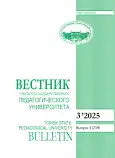Сохранение компонента синестезии как разновидности метафоры в переводах романа И.С. Тургенева «Дворянское гнездо» на английский и французский языки
- Авторы: Дроздова М.Н.1,2, Кобенко Ю.В.1
-
Учреждения:
- Национальный исследовательский Томский политехнический университет
- Сибирский государственный медицинский университет
- Выпуск: № 3 (2025)
- Страницы: 52 - 61
- Раздел: Статьи
- URL: https://ogarev-online.ru/1609-624X/article/view/297766
- DOI: https://doi.org/10.23951/1609-624X-2025-3-52-61
- ID: 297766
Цитировать
Полный текст
Аннотация
Об авторах
Мария Николаевна Дроздова
Национальный исследовательский Томский политехнический университет; Сибирский государственный медицинский университет
Email: drozdova.mn@ssmu.ru
аспирант, ассистент Томск, Россия
Юрий Викторович Кобенко
Национальный исследовательский Томский политехнический университет
Email: serpentis@list.ru
доктор филологических наук, профессор, профессор школы общественных наук Томск, Россия
Список литературы
- Кобенко Ю.В. Теоретические основы функциональной стилистики. Томск: Издательство Томского политехнического университета, 2023. 296 с.
- Кобенко Ю.В. Аспекты медийной коммуникации в социальных сетях // Вестник Санкт-Петербургского университета. Язык и литература. 2023. № 20 (1). С. 183–190. doi: 10.21638/spbu09.2023.111
- Алексеева И.С. Текст и перевод. Вопросы теории. М.: Междунар. отношения, 2008. 184 с.
- Литвиненко В.С. Тенденции передачи стилистической конвергенции в переводах лимериков Э. Лира // Реализация компетентностного подхода в системе профессионального образования педагога. 2018. С. 235–237.
- Сафина Л.М., Кобенко Ю.В. Особенности перевода военно-административных и военно-исторических реалионимов в повести Н.В. Гоголя «Тарас Бульба» (на материале английского, французского и татарского языков) // Вестник Томского государственного педагогического университета. 2023. Вып. 3 (227). С. 48–57. doi: 10.23951/1609-624X-2023-3-48-57
- Тургенев И.С. Дворянское гнездо. М.: АСТ, 2022. 350 с.
- Агапкина Т.Л. Славянские древности: этнолингвистический словарь: в 5 т. / под общ. ред. Н.И. Толстого. М.: Междунар. отношения, 1999. С. 273–275.
- Freeborn R. Ivan Turgenev Home of the Gentry translated by Richard Freeborn. London: Penguin Classics, 1970. 208 p.
- Garnett С., Turgenev I.S. A House of Gentlefolk (also known as Home of the Gentry) Translated by Constance Garnett. URL: https://originalbook.ru/a-house-of-gentlefolk-ivan-turgenev-english-dvoryanskoe-gnezdo-i-s-turgenev (дата обращения: 27.06.2023).
- Comte Sollohoub et A. de Calonne Tourgueniev I.S. Une nichée de gentilshommes, traduit du russe. URL: https://originalbook.ru/une-nichee-de-gentilshommes-i-tourgueniev-francais (дата обращения: 27.06.2023).
- Flamant F. Tourguéniev Premier amour Nid de gentilhomme, traduit par Françoise Flamant. Paris: Éditions Gallimard «Bibliothèque de la Pléiade», 1982. 374 p.
- Гак В.Г. Новый большой французско-русский фразеологический словарь. М.: Дрофа, 2005. 1648 c.
- Ralston W. Ivan S. Turgénieff Liza or a noble nest; translated from the Russian by W.R.S. London: Ward, Lock, 1869. 318 p.
- Hapgood E.F. A Nobleman’s Nest. URL: https://onlinebooks.library.upenn.edu/webbin/gutbook/lookup?num=25771 (дата обращения: 27.06.2023).
- Pursglove M. Ivan Turgenev. A Nest of Gentry. Translated by Michael Pursglove. Richmond U.K.: Alma Classics LTd, 2016. 236 p.
- Isaacs B. A Nest of The Gentry. Moscow: Foreign Languages Publishing House, 1947. 178 p.
- Lichnevski M. I. Tourgueniev Un nid de gentilshommes, traduit par M. Lichnevski. Paris: Payot, 1927. 301 p.
- Кретов А.А., Фененко Н.А. Динамика имплицитного и эксплицитного в переводе // Межкультурная коммуникация и проблемы национальной идентичности. 2002. С. 135–142.
- Ожегов С.И. Толковый словарь русского языка. URL: https://ozhegov.slovaronline.com/3408-VKUS (дата обращения: 30.08.2024).
- Harper Collins Free online dictionary, thesaurus and reference materials. URL: https://www.collinsdictionary.com/dictionary/english/taste (дата обращения: 30.08.2024).
- Ушаков Д.Н. Академический толковый словарь русского языка. URL: https://dic.academic.ru/dic.nsf/ushakov/1049710/СЫРОМОЛОТНЫЙ (дата обращения: 28.08.2024).
- Oxford English Dictionary. URL: https://www.oed.com/search/dictionary/?scope=Entries&q=upstart (дата обращения: 30.08.2024).
Дополнительные файлы







